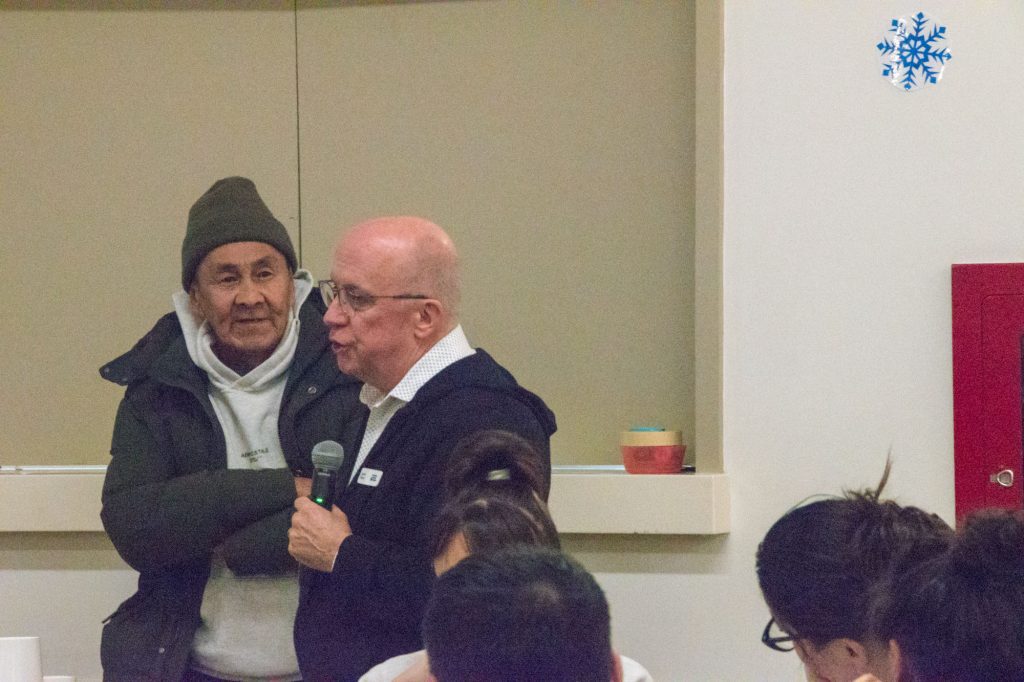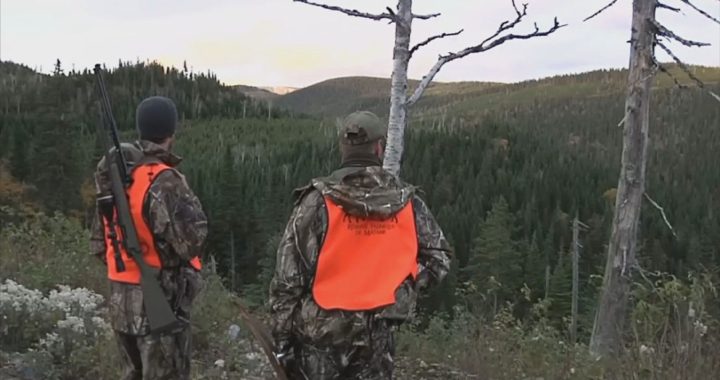
Laurie Pushor speaking to attendants at a meeting in Fort Chipewyan. Photo: Danielle Paradis/APTN
At a tense community meeting, Athabasca Fort Chipewyan First Nation (ACFN) Chief Allan Adam served the Alberta Energy Regulator (AER) with lawsuit papers over a leaking tailings pond.
“As the chief of the Athabasca Chipewyan First Nation I am handing you these documents that say we are going to court … we are suing you for the damage that you have caused the community of Fort Chip,” said Adam, holding the court documents in the air.
“We have had enough.”

Roy Labouceur, a pipe carrier and ACFN member opened the meeting by drumming and reminding everyone present to have respect for “Mother Earth” and one another.
There were about 75 people in attendance.
In 2022, the community discovered that there had been a leak in a tailings pond for nine months and a secondary overland spill the leak was an estimated 5.4 million litres, or enough to fill two Olympic-sized swimming pools. Imperial Oil reported this to the AER on Feb. 4.
For much of the meeting, people in attendance spoke with frustration about the failure of the regulator to notify the community.

“The failings of the AER in relation to the Kearl Facility are also symptomatic of deficiencies in the provincial regulatory system as a whole, including its lack of consultation or consideration for how cumulative impacts affect ACFN’s aboriginals Treaty rights,” reads the statement of claim.
“The Defendants knew or ought to have known that ACFN would be harmed by the uncontrolled discharge of tailings flowing into land waterbodies feeding the Athabasca and Firebag Rivers. The AER had a duty of care to ACFN as a downstream First Nation and a duty to warn ACFN about the discharge of tailings from Kearl Facility tailings ponds.
“The AER failed to carry out this duty and this breach harmed ACFN’s ability to exercise their Treaty rights on their traditional territory safely.”
Read More:
‘We are probably going to be the first oil sands environmental refugees’
While tailings pond leaked, Imperial Oil lobbied Alberta government on ‘cost effective’ regulation
The lawsuit is asking for “all or part of the royalties, or equivalent payments received, it in relation to the Kearl Project during the time of the Uncontrolled Discharges from May 2023 to November 2023, and to pay said royalties to ACFN.”
The statement of claim said that the province of Alberta received $50 million a month during that time.
Fort Chipewyan Métis President Kendrick Cardinal also spoke passionately about the effects of mining on his community.

“I don’t want to be a part of it anymore … if it was up to me I would shut down the oil sands today,” said Cardinal. “Don’t try to line our pockets. That is what is happening.”

The lawsuit came near the end of a meeting where several staff from the provincial regulator came to Fort Chipewyan- to answer questions about Imperial Oil’s Kearl mine site.
Laurie Pushor, the CEO of AER, spoke to APTN News after the meeting.
“I believe in the democratic institutions in this country. They’re important and anyone should feel free to take advantage of them … we will respond appropriately,” said Pushor.
Concerns about health in the community

Kearl mine is about 300 km south of Fort Chipewyan where many members of the Mikisew Cree Nation, Fort Chipewyan Metis Nation and Athabasca Chipewyan First Nation (ACFN) live.
“I got a graveyard full of family and friends that you killed. The blood is on your hands,” said ACFN Councillor Mike Mercredi.
Mercredi was outspoken at several points during the meeting.
“Why are you further monitoring and doing nothing? Your regulations are being broken … your rules are being broken,” said Mercredi.
Some of the community is concerned about cancer rates and instances of a rare bile duct cancer.
A 2014 study looked at cancer rates between 1992 and 2011 and found slightly higher-than-expected levels of cancer. The types of cancer identified were bile duct cancer, cervical cancer, and lung cancer.
Researchers said they would expect 79 cases in a community of Fort Chipewyan’s size, they found 81. There have not been recent studies about the cancer rates in Fort Chipewyan.
“Everything is going downhill,” said Elder Edward Flett to APTN talking about the changes he has seen in the water. “My traditional way of life … it has been drying up with no water. Climate change just changes everything.”
Differing community reaction
Ernest Thacker, a Fort Chipewyan Métis member, was not at the meeting. He spoke to APTN earlier in the day and said that he does not find the meetings productive. Thacker is an avid fisher and described himself as an “oil sands groupie”.
He also said he was not concerned with the water quality in the community and described the fish from Lake Athabasca as the “best in the world.”
“We can’t all wave a flag and say save the planet you know, somebody’s gotta work,” said Thacker.
Thacker said he has not noticed any defects with the fish he catches.
“I feed them to my children and my grandchildren,” said Thacker.
He feels that the best way for Indigenous people to make sure that the community is safe is to participate in industry.
“The best thing to do with the oil sands is to get on the inside,” said Thacker. “Imagine where Fort Chip would be if we were inside from the get-go.”
The burning of fossil fuels is the leading cause of the climate crisis.
The AER committed to further in-person meetings at Fort Chipewyan.










